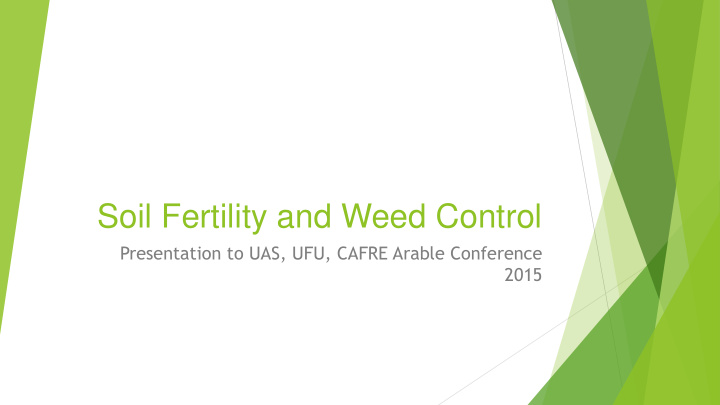



Soil Fertility and Weed Control Presentation to UAS, UFU, CAFRE Arable Conference 2015
Introduction Farming in Co Meath with two thirds arable, one third grassland/ commercial forestry. Growing a wide range of combinable crops. Co Meath was traditionally known as cattle finishing land, now widespread tillage cropping with a number of very large potato producers. Silty clay loam soils, not inherently free draining. Not ideal tillage soils but potentially very high wheat yields. Average yearly rainfall of 850mm
2001: A watershed Moved away from fully plough-based system in 2001. Power harrows should come with a soil health warning. Power harrows batter wet soils into submission. Soils were suffering. Continually forcing autumn seedbeds is farming without a future. Move to min till and shallow cultivations. Straw incorporated. Initially successful, top 3-4in became very friable, like a flower bed. Problems with compaction and water infiltration soon developed
SIMBA SOLO AT WORK WITH GOOD STRAW INCORPORATION AND DEEP LOOSENING.
Drawbacks and challenges Establishing spring min till crops has proved problematic on our heavy land. Obvious yield penalty over conventional establishment. Spring crops are rotationally important to us – spring OSR, beans, barley. Cultivating in the autumn for spring crops doesn’t work. Cultivating in the spring doesn’t work either. Soils come up slabby and are light years away from a traditional spring seedbed. Cover crops are probably the missing link
Benefits of Min Till to date Utilised successfully over the last 13 years. No yield penalty on winter crops. Occasional breaks due to poor weather (years of 08, 09, 12). Soil is in much better condition with residue incorporation and good friability. Organic matter content stable at around 5.5%. Establishment costs (metal and diesel) have fallen considerably (20L diesel/ha). Increased work rates. Water infiltration is good. Weeds challenges and pressure haven’t hugely increased.
Strip-Till: A logical progression from min till?
Changing from min till to zero till? Zero till first appeared in the 1970s, then known as direct drilling. Renewed interest now. Several strip till farmers progressing to zero till. Drill directly into the stubbles, with no deep loosening. Advocates claim an increase in worm activity and soil micro organisms. Ultimate in low cost establishment and sustainable low carbon farming. Why might it succeed this time around? BEWARE; REDUCED COSTS WITH REDUCED OUTPUT IS NO GOOD. Strip till with localised deep loosening under the seed band seems right. That’s a no to zero till for me.
Blackgrass and Sterile Brome Cultural control of sterile brome important (stale seedbeds) Importance of oilseed rape in rotation to control grassweeds. Thankfully we don’t (yet) have to battle with the blackgrass scourge. Reports of isolated outbreaks across Ireland are extremely concerning. Be vigilant and take remedial action for any outbreaks. Having to deal with blackgrass in addition to high levels of disease pressure could be lights out for cereal production in Ireland from a cost point of view. Use of (mainland) UK imported seed should be avoided if at all possible .
Cover Crops: The missing link? Mop up available nitrogen for the following crop. Their root activity keeps the winter soil open, active and alive. Provide valuable nutrients for earthworms and other beneficials. Some species can help reduce compaction and plough pans. Improve filtration rates? Alleviate the soil from capping caused by heavy winter rainfall Potentially very useful in allowing spring crops to be successfully sown using reduced tillage methods. Choice of cover crop must suit your rotation (e.g. club root threat)
What cover crops can do for your soil
Muck and Magic A good cost-effective source of muck is invaluable but difficult to find. Benefits can be difficult to quantify. Range from no obvious effect to a totally flat field of wheat. The really unpleasant stuff is usually free but for good reason! Good pig slurry can be cost-effective as equipment to handle it may be already on farm. Don’t underestimate the value of cover crops and incorporated crop residue in this regard. It’s easy to be a busy fool with some organic wastes. Granular fertiliser might well be a cheaper option with predictable results.
Recommend
More recommend